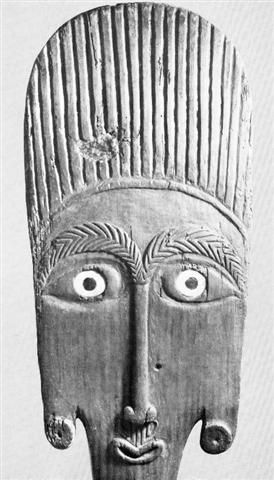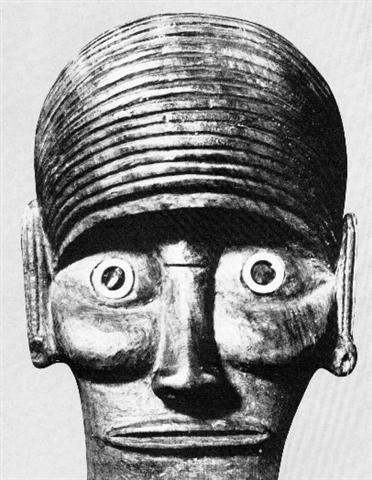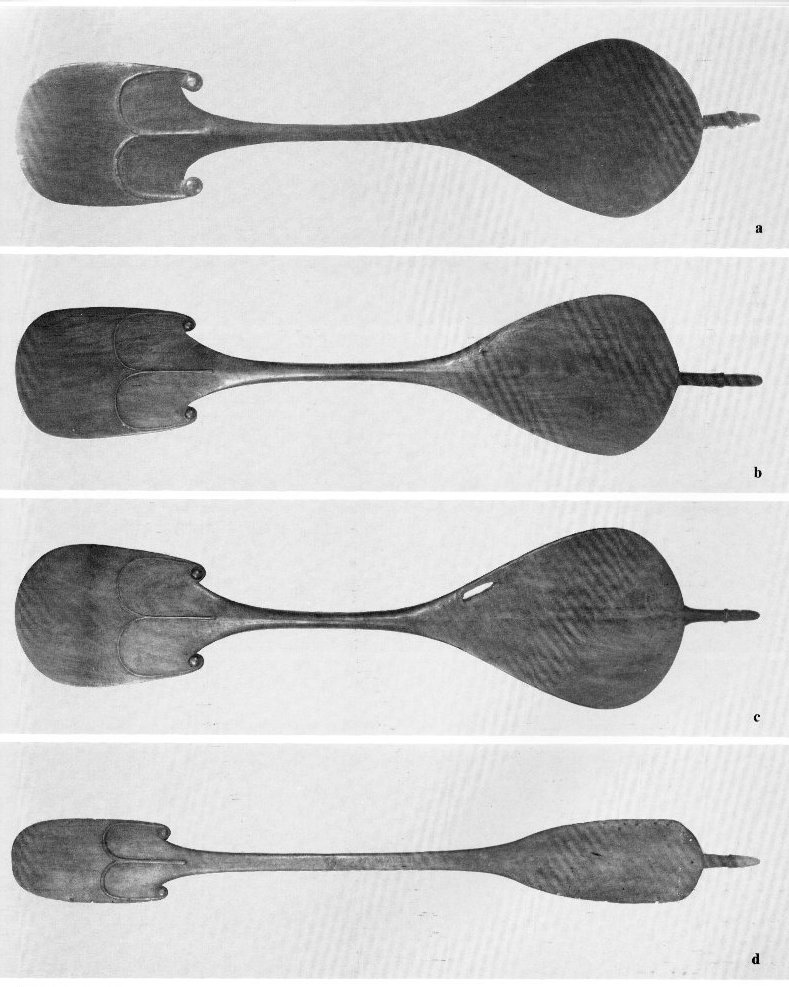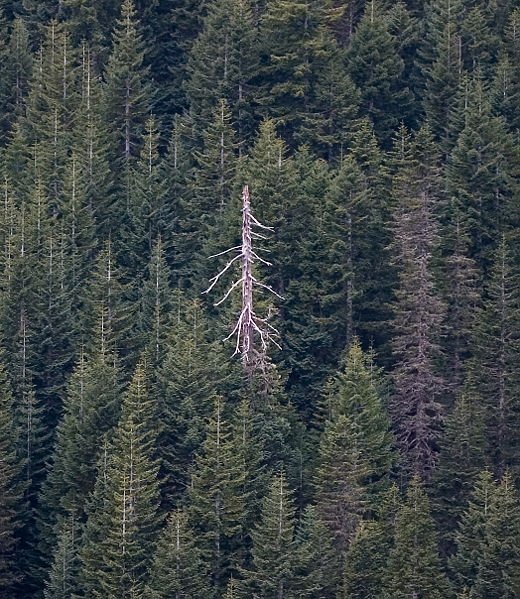|
TRANSLATIONS
Next page in the glyph dictionary:
|
3. There
are two kinds of 'dance paddles', rapa and ao,
agreeing in general shape and having a face at the top end, or to be
more accurate - two equal faces, one on each side (like the double
faces on a ua staff). The picture below shows an ao
(large dance paddle):

(Ref. Heyerdahl 3)
The forehead is visible and the 'hair' stands on its end (probably
illustrating feathers or sun rays). I guess we here see high summer
time expressed by visual cues. If we compare with the ua
staff, we now can idenify
winter signs of darkness:

The sky vault (the grooves) lies close to the ground
and even the horizontal mouth is like a slit. The 'strongly
projecting pouches' which hang down below the eyes are like moon
crescents. The pupils are enlarged to let in as much light as
possible.
The nose is not as long as in the ao
paddle and the face is compressed from above, resulting in pouches,
while in the ao paddle the face is fully stretched out. The
word rapa implies a flat surface, without wrinkles.
If ua glyphs represent ua staffs, then they should
occur in winter, not in summer. When it rains (ûa) sun is
usually not seen. |
| Ao, aô Large dance paddle.
1. Command, power, mandate, reign: tagata
ao, person in power, in command, ruler. 2. Dusk, nightfall. 3. Ao
nui, midnight. 4. Ao popohaga, the hours between midnight and
dawn. Aô, to serve (food); ku-âo-á te kai i ruga i te kokohu,
the food is served on a platter. Vanaga.
1. Authority, kingdom, dignity, government, reign (aho);
topa kia ia te ao, reign; hakatopa ki te ao, to confer
rank; ao ariki, royalty; ka tu tokoe aho, thy kingdom
come. PS Mgv.: ao, government, reign. Mq.: ao, government,
reign, command. Sa.: ao, a title of chiefly dignity; aoao,
excellent, surpassing, supreme. 2. Spoon; ao oone, shovel. 3. Dancing club
T. 3. Aonui (ao-nui 2), midnight. 4. Pau.: ao, the
world. Mgv.: ao, id. Ta.: ao, id. Mq.: aomaama, id.
Ma.: ao, id. 5. Pau.: ao, happy, prosperity. Mgv.: ao,
tranquil conscience. Ta.: ao, happiness. 6. Mgv.: ao,
cloud, mist. Ta.: ao, id. Mq.: ao, id. Sa.: ao,
cloud. Ma.: ao, id. 7. Mgv.: ao, hibiscus. 8. Ta.: ao,
day. Mq.: ao, day from dawn to dark. Sa.:
ao, id. Ma.: ao, id. 9. Ta.: ao, a bird. Ha.: ao, id.
10. Mq.: ao, respiration, breath. Ha.: aho, breath. 11.
Mq.: ao, to collect with hand or net. Sa.: ao, to gather.
Ma.: ao, to collect. Ta.: aoaia, to collect food and other
things with care. Churchill. |
| "The ao and rapa
differ from each other mainly in size and in decoration, but are
otherwise closely related. Both were double-bladed paddles twirled
and shaken in the hand during ceremonial dances. The ao was
the larger of the two types, with a total length that could exceed 6
ft. (2 m.). One blade of the paddle, usually
pointing up during dances, has a conventionalized human face carved
and painted on each of its sides. The blade itself is carved flat as
on a functional paddle, with almost parallel edges and a rounded
distal end.
The nose is very long and extremely narrow, and
forks into two prominent eyebrows. This curved, Y-shaped combination
of nose and eyebrows is slightly raised in relief. The eyes are
carved and painted much larger than the mouth, which is either
reduced to a minimum or lacking. The ears, however, are invariably
present and carved in a conventionalized manner as two downward
projecting lobes with circular earplugs.

One very old and worm-eaten sample (Boston
64845) has fish vertebrae inserted as earplugs. The specimen,
collected by Agassiz' Albatross Expedition as late as 1904-5, has
doubtless been kept hidden in a cave. A large portion of the upper
blade, corresponding to the broad and tall forehead, is covered by
dense rows of vertically painted stripes that may indicate hair
although in some specimens they definitely assume the aspects of a
feather-crown of the type common in aboriginal Easter Island.
Some specimens have vertical tear marks painted as
parallel stripes running from the bases of the large eyes down
across the chin. This 'weeping-eye' motif is particularly pronounced
on the ancient ao symbols preserved as mural paintings on the
slabs in the ceremonial houses of Orongo (Ferdon, 1961, Figs.
65 b, f and Pl. 29 c; this vol., 183 a). Some faces on ao
paddles are painted with geometric fields suggesting tattoo.

Only one twin-faced blade of the ao is
painted; the rest of the paddle is left polished and plain. A slim
handle with an oval cross-section that becomes almost circular at
mid-length connects the painted blade with the other one which is
undecorated. It has the same outline except for the lack of
indentations carved below the earlobes of the decorated blade.
In some specimens the second blade is slightly
narrower and has a rounded rectanguloid outline. A fingerlike
projection with a ring-shaped band in relief around its midsection
is sometimes, but not always, carved at the center of the distal end
of this second blade. In some specimens the ring is replaced by a
steplike transition from a wider upper part to a narrower lower
part. This extension corresponds to the knob carved elsewhere on
some functional paddles and serves for pushing off or staking
operations." (Heyerdahl 3) |
|
Rapa 1. To shine; shiny, polished; he-rapa te moai
miro, the wooden figurine is shiny, polished. 2. Emblem, badge of
timo îka (person entrusted with putting a death spell on an
assassin). Rapahago, name of a spirit (akuaku), anciently
considered as benevolent; rapahago, a fish. Raparapa, to
dazzle; dazzled: he-raparapa te mata. Marîa raparapa,
calm, smooth shiny sea. Vanaga.
1. Pau.: rapa, a fool,
madness. Ma.: rapa, a familiar spirit. 2. Pau.: rapa, blade of a
paddle. Mgv.: raparapahoe, id. Ta.: rapa, id. Mq.: apa,
id. Sa.: lapa, flat. Ma.: rapa, flat part of a shovel. 3.
Pau.: rapae, a sand-pit. Ta.: rape, arapai, id. 4.
Mgv.: rapahou, primipara. Ma.: rapoi, id. 5. Mgv.:
raparapa, green. Ta.: rapa, id. 6. Mgv.: raparapa,
flat. Ta.: rapa, a flat rock. Sa.: lapalapa, a flat coral.
Ma.: raparapa, the flat part of the foot. 7. Ta.: raparapa,
square. To.: labalaba, id. Ha.: lapalapa, square (of
timber, of a bottle, of a cow yard). Churchill. |
The nose on the ua staff should be a
snag, a dead old tree:

|